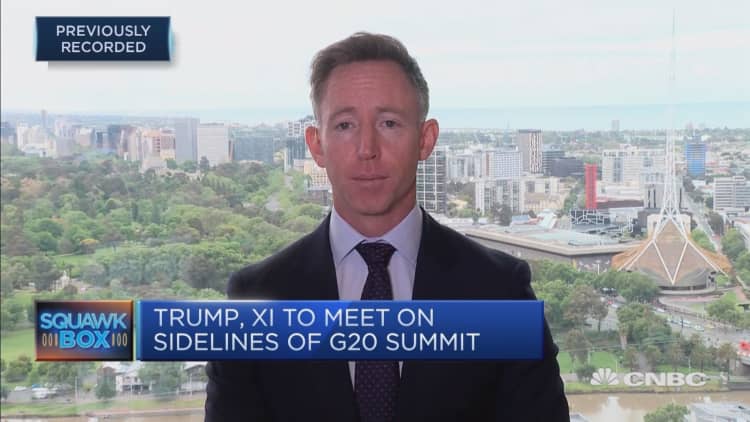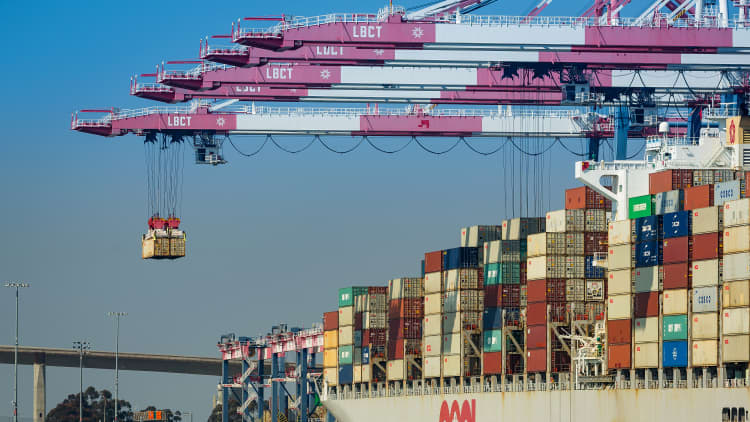China's currency will likely continue its slide against the U.S. dollar — possibly falling below the key 7.00 yuan per dollar level — if Washington and Beijing fail to step back decisively from an all-out trade conflict at this week's G-20 summit in Argentina.
Most global macro and currency strategists contacted by CNBC are not optimistic of a breakthrough at the meeting between U.S. President Donald Trump and his Chinese counterpart Xi Jinping on Nov. 30 and Dec 1.

"This is about much, much more than just a trade surplus," said Jonathan Pain, author and publisher of the weekly Pain Report. "We are at the early stages of a long drawn out economic war between America and China."
Michael Every, head of financial markets research Asia-Pacific at Rabobank, characterized the likely upshot of G-20 as "can-kicking at best." The Chinese president "can't deliver on anything the U.S. wants and needs. Hence no deal," he said.
Every said long positions, or bullish bets, on the U.S. dollar and short yuan, or bets the Chinese currency would fall, made sense under such a scenario. He also said the will likely rise "if risk really accelerates too rapidly."
National Australia Bank's currency strategist Rodrigo Catril is expecting a "hollow truce" — where the U.S. agrees to temporarily hold off on further tariff action and both sides agree to talks at a future date to diffuse tensions on a more permanent basis.
Handshake deal
While it didn't rule out China and the US reaching a "handshake agreement" at the G-20, Fitch Solutions said that "any warming of relations would likely be short-lived, as the world's leading economies remain far apart on key issues, including (intellectual property) theft, market access, and state control of industry."
Even a "temporary truce may be off the table," Fitch Solutions warned, citing recent events such as U.S. officials ramping up hawkish rhetoric and the U.S. Trade Representative releasing a scathing report on China's technology practices ahead of the summit.
I am expecting a deal — or more a move forward, not backward.Patrick Bennettmacro strategist at CIBC Capital Markets
Whether negotiators deliver a framework, a fudged deal or a handshake agreement, it won't be enough to convince financial markets that the major structural differences at the heart of the trade conflict have been fully settled.
U.S. demands are "too broad ... and the asks too unclear, for it to be a final deal," said Rachel Ziemba, adjunct senior fellow at the Center for a New American Security. "Plus, I think there are plenty of actors in the U.S. that are wary of any deal with the Chinese. This suggests a long negotiation — a view which is becoming shared in the market place."
"There is far more than trade at stake here and it seems far too soon for all U.S. grievances to be addressed in just a single summit," added Gareth Berry, a foreign-exchange and rates strategist at Macquarie. "A lack of agreement at the bilateral meeting on the sidelines of the G-20 would tend to push (the U.S. dollar-Chinese yuan exchange rate) higher — this is where the action will be."

At the G-20 summit in Hangzhou two years ago — even before Trump was elected — CNBC reported that while the billionaire presidential candidate was not at that meeting, his perceived anti-trade rhetoric loomed large and threatened to spook the globalization crowd gathered there.
Standard Chartered warned at that time there were hints that both the U.S. and China had "adopted a more protectionist stance on global trade."
Wild card
The — a barometer for emerging market risk — could also come under pressure should there be no meaningful headway between the U.S. and China, Macquarie's Berry said. However, he added, "the impact will be fairly mild."
How the G-20 meeting might affect the dollar-yen is still a "wild card," Berry said, as the currency pair could be "caught in the crossfire between upward pressure from a stronger USD and downward pressure from a mild increase in global risk aversion."
I am expecting a fudge — an announcement of some sort of agreement that isn't very robust when scrutinized.Sean Callowsenior currency strategist at Westpac
Nonetheless, there are reasons for optimism.
"I am expecting a deal — or more a move forward, not backward," said Patrick Bennett, a macro strategist at CIBC Capital Markets. "Trump has made his point well, China have been reserved in their responses, but to my view are willing to concede some greater market access — that is what this is ultimately about."
Were China to yield some ground, the Australian dollar, "which has been the whipping boy for anything resembling trade tension," would gain, Bennett said. Rallies in China's currency, however, would be "countered by concern of economic outlook, but weakness on trade tensions also has been overcooked," he added.
Additionally, the recent sell-off in U.S. stock markets — triggered in part by investor concern over a tariff-induced growth slowdown — could prompt Trump to dial down on his tariff threats.
Half-way house
"Given Trump's evident sensitivity to the stock market ... maybe we get some sort of half-way house out of G-20," said Ray Attrill, head of currency strategy at National Australia Bank.
He explained it could mean that the U.S. president commits to upping the tariff rate on the $200 billion to 25 percent from January — from the current 10 percent — but holds off announcing his intent to impose additional tariffs on the remaining $267 billion.
"Even if the latter scenario plays out though, I'd still think that will be at least modestly risk-negative, offering some support for USD and JPY and somewhat undermining recent AUD and NZD gains," said Attrill.

A G-20 meeting ending in "acrimony and threats of further punitive action" is least likely, according to Sean Callow, senior currency strategist at Westpac. "More plausible but still not my base case, is a genuine breakthrough."
A breakthrough, he explained, would be a U.S. commitment to shelve tariffs on the next round of $267 billion of Chinese imports and to suspend the threatened 25 percent tariffs that were set to take effect on January 1, 2019.
The base case, Callow said, "is something in between, but erring on the side of insubstantial — big smiles and handshakes ... Trump proclaiming a big win for U.S. exporters but (with) the key tariffs timetable still in place as negotiations are set to continue in December."
Should the results be insubstantial, the Australian dollar and the Chinese yuan would bounce but not soar, Callow said, adding that the Aussie dollar could be firmer by 1 percent and the yuan by 0.5 percent.
The Japanese yen would probably weaken a bit, "assuming equities and US yields rise," Callow said. "I am expecting a fudge — an announcement of some sort of agreement that isn't very robust when scrutinized."


